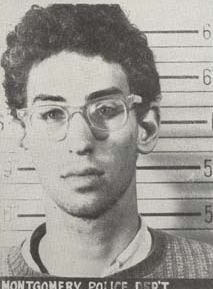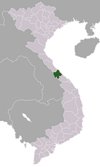Alexander D. Shimkin facts for kids
Quick facts for kids
Alexander Demitri Shimkin
|
|
|---|---|

Alexander Shimkin after he was arrested for civil rights activity in Alabama in 1965
|
|
| Born | October 11, 1944 Washington, D.C.
|
| Died | July 12, 1972 (aged 27) Quảng Trị Province, Vietnam
|
| Nationality | American |
| Alma mater | |
| Occupation | war correspondent |
| Known for | investigating non-combatant casualties in Operation Speedy Express |
| Military career | |
| Battles/wars | Vietnam War
|
Alexander Demitri "Alex" Shimkin (born October 11, 1944 – died July 12, 1972) was an American war correspondent. This means he was a journalist who reported on wars. He was killed while reporting from Vietnam. Alex is remembered for looking into how many ordinary people were hurt or killed during a military action called Operation Speedy Express.
Contents
Alex's Early Life and Civil Rights Work
Alex Shimkin was born in Washington, D.C.. In 1960, his family moved to Urbana, Illinois. His parents were anthropologists (people who study human societies and cultures) at the University of Illinois. Alex was very interested in military history, even making notebooks about armies from World War I.
After finishing Urbana High School in 1962, Alex went to the University of Michigan to study history. In 1965, he left college to join the Civil Rights Movement. This movement worked to end unfair treatment and gain equal rights for African Americans.
Alex worked with groups like the Northern Student Movement in Alabama and the Mississippi Freedom Democratic Party (MFDP). After a peaceful march in Selma was attacked, Alex went to Selma to join another march led by Martin Luther King Jr.. He was arrested twice during these events.
In Mississippi, Alex was arrested with many others in Natchez in October 1965. They were held for three days in a cold prison. He even wrote a guide about local politics and the right to protest.
In 1966, Alex worked full-time for the MFDP in Quitman County. He joined the March Against Fear and helped organize a Head Start program. This program helps young children from low-income families. He also helped register over 6,000 African Americans to vote. Alex once wrote that he had given almost all his time to the civil rights movement since he was just twenty years old.
Volunteering in Vietnam and the Ba Chúc Story
Alex returned to his studies and graduated from Indiana University in 1969. After that, he became a community development worker with International Voluntary Services (IVS) in Laos and South Vietnam.
While working in Vietnam, Alex and another volunteer, Ronald Moreau, shared a story with New York Times reporter Gloria Emerson. Their story, published in 1971, was about how South Vietnamese officers and their American advisors forced Vietnamese villagers to clear land mines near the village of Ba Chúc. The villagers were made to use hand tools, which led to several deaths and serious injuries when the mines exploded.
After the story was published, the Pentagon (the U.S. military headquarters) ordered the mine-clearing operation to stop. However, Alex and Moreau were fired by IVS for speaking to the press without permission. Gloria Emerson then helped Alex get a job as a stringer (a freelance journalist who reports for a news organization) for Newsweek magazine.
Investigating Operation Speedy Express
Working for Newsweek, Alex Shimkin looked at documents from the United States Military Assistance Command, Vietnam (MACV). He noticed something strange about Operation Speedy Express, which happened in the Mekong Delta from December 1968 to May 1969. The American military claimed they had killed 10,899 enemy soldiers, but they only reported capturing 748 enemy weapons. This big difference made Alex suspicious.
Alex researched more and interviewed American officials and Vietnamese people. He concluded that many of the people reported as "enemy dead" were actually unarmed Vietnamese civilians. Their deaths, whether accidental or on purpose, were used to make the "body count" look higher. The body count was how commanders measured the success of the operation.
One specific event Alex uncovered was at Thanh Phong in February 1969. In this incident, U.S. Navy SEALs killed 21 civilians, and these deaths were added to the enemy body count. This information did not become public until 2001.
Alex and his boss, Kevin P. Buckley, wrote a long story for Newsweek. It said that "thousands of Vietnamese civilians have been killed deliberately by U.S. forces." Later, a secret U.S. Army report agreed that civilian deaths were "substantial," possibly between 5,000 and 7,000.
Newsweek editors shortened the story because they worried it would seem like an unfair attack on President Richard M. Nixon after the My Lai Massacre news. The story, called "Pacification's Deadly Price," was published on June 19, 1972, but it did not get much attention. Alex was killed a few weeks later.
Shimkin at Trảng Bàng
On June 8, 1972, a month before he died, Alex was among the journalists at Trảng Bàng. This was when photographer Nick Ut took his famous picture of nine-year-old Vietnamese girl Phan Thị Kim Phúc and other children running from a napalm attack. Two South Vietnamese planes accidentally dropped bombs near the journalists. This caused two children to die and seriously burned others, including Kim Phúc.
Alex reportedly shouted, "Jesus! People have been bombed!" A photo taken by David Burnett shows a man running with his arm out towards Kim Phúc. Some believe this man might be Alex Shimkin. Moments later, Alex was seen crying and asking to be left alone.
Rescue on Route 13
In early July 1972, Alex was covering fighting north of Saigon on National Route 13. He bravely went to help a wounded South Vietnamese soldier and carried him to safety while under heavy mortar fire. A photograph of this rescue appeared in a Saigon newspaper on July 7 and later in Newsweek.
Alex's Death
On July 12, 1972, Alex Shimkin and another reporter, Charles "Chad" Huntley, got lost in Quảng Trị Province. They were covering military operations to push North Vietnamese forces out of the area. They left their Jeep and walked into an attack by North Vietnamese soldiers. Alex, who spoke Vietnamese, tried to talk to the attackers, but he was killed.
Chad Huntley said, "The last time I saw him he was standing straight up with his arms stretched out with a grenade lying about two feet from his feet... An explosion occurred, he started to crumple...." Huntley, a former U.S. Special Forces soldier, was only slightly hurt and escaped because of his military training.
Alex Shimkin's body was never found. The Department of Defense listed him as "missing in action." Even though some thought his grave was located in 2002, his remains have not been found as of 2018. An interview with Chad Huntley about the attack is kept at the Library of Congress.
Personal Interests
Alex told an interviewer in 1965 that a college course in classical literature gave him "a certain philosophical perspective." He enjoyed novels by William Faulkner and Theodore Dreiser. He also liked reading about political science and American history. At the time of his death, he had been accepted to Princeton University for graduate studies. He hoped to write the "definitive history" of the Vietnam War. Alex also played rugby at Indiana University.
Memorials
Over 70 books from Alex Shimkin's military history collection are kept at the library of the University of Illinois at Urbana-Champaign. Alex is also remembered at the Journalists Memorial at the Newseum in Washington, D.C. A memorial tree honoring him was planted in 2014 at Indiana University Bloomington. There is also a memorial stone for him at The Homewood Cemetery in Pittsburgh, Pennsylvania.
Images for kids
See Also
- List of journalists killed and missing in the Vietnam War




